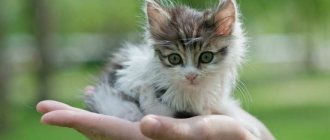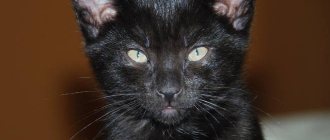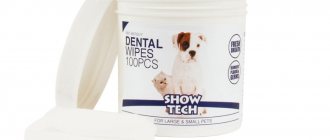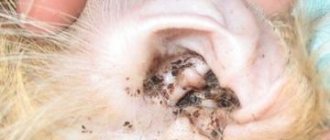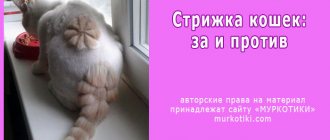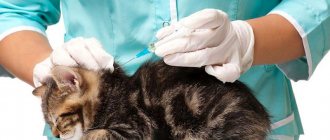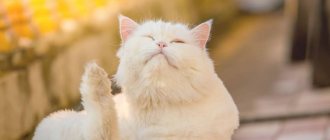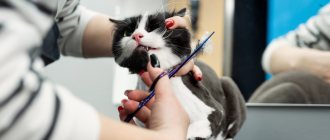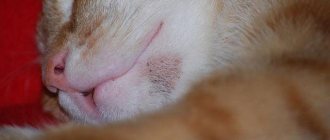If a kitten is left without a mother, its survival depends entirely on how well you organize its care. The ideal option is to find a surrogate cat mother for the baby who can feed the kitten (or kittens, if several were born). But this is not always possible. Therefore, if you are forced to cope on your own, the most important task should be to provide the kittens with food and warmth. Raising a kitten without a cat is quite possible, but you must understand that newborn kittens without a mother are very vulnerable, and you will need patience to care for them.
General principles of care at 1 month
Before you bring a small kitten into your home, you need to carefully consider the environment and prepare everything you need to make caring for a 1-month-old kitten easier. You should start caring for a small kitten by purchasing the following products:
- Cat litter;
- Bowls for food and drink;
- scratching post;
- Claw clipper;
- Sleeping basket;
- Brushes for combing wool;
- A bag or cage for carrying;
- Toys.
It is important to remember that the sooner you begin to accustom your baby to care procedures, the calmer he will perceive them in the future.
© shutterstock
From the first days of life in your home, your pet must explore the territory and get used to the new environment. If you have a large apartment or a private house, then it is better to start getting used to it in one room, where the baby will be comfortable sleeping, playing or watching others.
After he gets used to it a little, you can offer water or milk, but feed only in a pre-designated place, where, subsequently, he will always have to eat.
Pet's personal space
It is necessary to create optimal conditions in the room where your small pet will live. The temperature at home is allowed from 17 to 25 degrees. The apartment should not have drafts or open windows in cold weather. Babies still have a weak immune system, so they need to be protected as much as possible from hypothermia and possible infections, and limit contact with other pets.
What does a pet kitten need? For dishes, the baby will need 3 plastic or glass bowls:
- for some water;
- for dry food;
- for wet food.
A scratching post should be purchased with the kitten. You will immediately teach your baby to sharpen his claws in the right place and he will not have to tear up furniture and wallpaper. The habit of sharpening claws is in the blood of cats, and the point is the cat’s harmfulness or misunderstanding, but a natural necessity. You can choose a useful accessory in the form of a column or stand. The product must be wrapped with sisal thread. To attract your baby, you can spray the complex with catnip, which is so attractive to meowing creatures. The kitten is brought to the scratching post and shown what to do.
A carrier is a must if you are getting a kitten. It is convenient to go with it to a veterinarian for examination, take your pet to an exhibition, and take it with you on trips and trips. You can find plastic and fabric variations in pet stores. While the kitten is small, it can be used as a first house.
It is important to have special brushes for grooming the fur. For shows and exhibitions you will need slickers or slickers; daily use is contraindicated.
Every baby will need toys. There is no need to buy all the shelves; 3-5 functional and developmental accessories will be enough. It is advisable for the kitten to have:
- ball;
- beanbag;
- mouse on a string;
- feather on a stick.
Place the toilet in a quiet place. It is better to take a tray with low sides. 15 minutes after feeding the baby can be dropped off. It is advisable to take the used litter from the breeder and mix it with clean litter in the toilet.
Claws
Cats' claws are a very important element that requires proper care and attention. From the first days in a new home, the pet needs to be shown a place where it can scratch its claws with impunity. This can be a specially made scratching post, or just a piece of carpet attached to the wall.
From time to time the claws should be trimmed, but very carefully . To do this, you need to fix the kitten's paw in a comfortable position and cut off the very tip of the overgrown claw with a nail clipper. This nail care procedure needs to be carried out once every two to three weeks.
Feeding issues
Caring for animals necessarily includes proper feeding.
Babies aged 3-4 months are fed at least 4-5 times a day; after 6 months, 3 meals a day are allowed; adults over 1 year of age are fed twice a day.
Nutrition should be balanced, but many foods from the human table are prohibited. The list of products harmful to kittens includes:
- chicken tubular bones – when chewed, they give sharp edges. A sharp fragment can damage the esophagus or stomach, which often leads to the death of the pet;
- Pork is too fatty meat, so it is not suitable for feeding pets. In addition, pork is a source of helminthiasis, so before feeding the kitten, you should think about the rest of the family members, and especially children who are in close contact with pets;
- smoked sausages and meat are harmful to the stomach of a four-legged pet, so delicacies should be avoided;
- milk - this product is useful for small kittens, but is completely unnecessary for adult animals. Milk causes lactose intolerance in cats and kittens, so it is better to avoid this product;
- sweets (bakery, candy, cookies) are harmful to your pet’s teeth and general health. And although some cats are happy to ask for candy, it is better to avoid feeding them sweets;
- fish - this product may be present in the animal’s diet, but not too often;
- legumes cause flatulence, so you should not give them to your pet;
- spices - lead to a deterioration in the animal’s sense of smell, and can also cause an allergic reaction, so they are not used when preparing dishes;
- chicken egg white is a strong allergen for your pet, so you should avoid introducing it into your diet.
A properly composed menu helps the kitten maintain and replenish its internal strength. There are two power options:
- industrially produced dry food;
- natural products.
If ready-made mixtures are used, this can significantly reduce the time spent caring for your pet. All you have to do is buy a suitable mixture, pour it into a plate and call the kitten. The attractive smell of the dish will make your pet try the new food.
You should purchase ready-made food at a specialized pet store. When purchasing, it is important to pay attention to the following things:
- shelf life of the feed;
- compound;
- the age of the pet for which the food is purchased;
- what breeds are the granules intended for?
- feed quality. Good foods are labeled premium or super-premium.
Cheap food seems profitable only at first glance. In fact, after eating cheap food compounds, pets develop numerous health problems. Trips to the veterinarian, tests, and examinations will not be cheap, so you should think carefully before purchasing low-grade food.
Natural products allow your baby to eat more healthily and closer to what nature intended. But not all animal owners are willing to spend precious time preparing healthy meals for their cats. List of healthy natural products needed to feed a cat:
- lean meats (poultry, beef) fresh or boiled. To prevent infection with helminthiasis, it is recommended to place meat in the freezer for several days;
- yolk no more than 2 times a week;
- chicken by-products (liver, heart);
- boiled or raw vegetables, crushed to a puree;
- porridge (oatmeal, buckwheat, barley) in small quantities;
- fermented milk products (kefir, sour cream, cottage cheese, unsweetened yogurt) with low fat content. It is not recommended to give completely fat-free ones.
All foods must be prepared without adding salt. Before pouring food into a bowl, it should be warmed up.
Teeth
When the kitten has already learned to eat solid food, he needs to brush his teeth every 1-2 days . This can be done with an ordinary cotton swab, carefully removing any remaining food remaining on the teeth and the resulting plaque. If you follow these recommendations, your pet will never have digestive problems.
© shutterstock
Wool and its care
Even if the baby has learned to lick himself, his fur still requires careful care. Regardless of the breed and length of the coat, it must be accustomed to grooming procedures from a very early age.
When examining the fur, make sure that there are no parasites in it, and also check the skin for redness, scratches and bald spots. For combing, it is better to choose a special comb that will match the length of the coat and is suitable for cats of this breed.
It is necessary to comb a long-haired kitten every day, or at least once every 2 days, to prevent the formation of tangles.
How to feed
It is better to feed the kitten exclusively with dry food, preferably Grandorf. It is expensive, but the best in all respects. It is better to invest money in good, high-quality food than to spend it on veterinarians later.
- You can choose two different nutrition programs: You can feed the kitten dry balanced food, or you can feed it from the table.
- This does not mean at all that you can feed him anything, this is a much more complex, time-consuming process when you need to select different proportions of meat, vegetables, grain yourself, combine all this and lay it out in portions.
- Everyone is free to choose for their pet what they want to feed it, but you should not resort to Whiskas, Kitekat and various cheap foods that are sold in supermarkets. If you feed your kitten good food that suits him, then you won’t need various vitamins and supplements.
Kitten toilet
Basically, trays are divided into three types:
- Closed trays;
- Open trays with fillers;
- Open trays with grids without fillers.
Closed trays are undoubtedly very convenient for cats, but they are quite expensive and not small in size, so such a tray is not suitable for every city apartment. Open litter trays are preferred by most breeders as they are relatively inexpensive and easy to maintain.
The most budget-friendly option is an open tray with a grid, but in this case one of the owners must always be at home to immediately clean up after the animal.
Taking care of your health
The well-being of pets depends 70% on the conscientiousness of the owners. Kittens cannot do without antihelminthics. Helminths can be localized not only in the intestines, but also in the heart, blood, muscles, and liver. For prevention, a tablet, drops or suspension is given. Antihelmintics are dosed strictly by weight and mixed with food. "IN-AP" anti-worm complex is used from 2 months, drops are applied to the back between the shoulder blades.
If weakness, loss of appetite, deterioration of fur, or problems with the eyes appear, the cat is taken to the veterinarian. If necessary, treat for fleas and ticks.
Primary vaccination is done at two months of age. Vaccinated from:
- plague;
- rabies;
- leukemia;
- rhinorrhea;
- panleukopenia.
Imported combined polyvalent vaccines are used.
When you take a kitten into your home, remember that now you are his closest relative. Don't leave him alone for a long time, take care, play, love, and you will raise a healthy, loyal pet.
